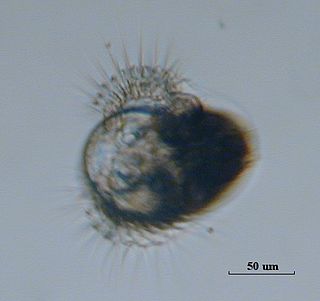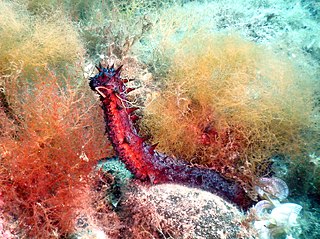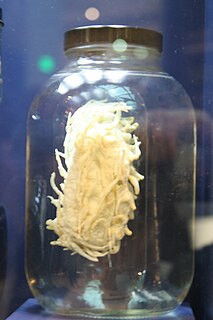
An echinoderm is any member of the phylum Echinodermata. The adults are recognisable by their radial symmetry, and include starfish, brittle stars, sea urchins, sand dollars, and sea cucumbers, as well as the sea lilies or "stone lilies". Adult echinoderms are found on the sea bed at every ocean depth, from the intertidal zone to the abyssal zone. The phylum contains about 7,000 living species, making it the second-largest grouping of deuterostomes, after the chordates. Echinoderms are the largest entirely marine phylum. The first definitive echinoderms appeared near the start of the Cambrian.

Sea cucumbers are echinoderms from the class Holothuroidea. They are marine animals with a leathery skin and an elongated body containing a single, branched gonad. Sea cucumbers are found on the sea floor worldwide. The number of holothurian species worldwide is about 1,717, with the greatest number being in the Asia-Pacific region. Many of these are gathered for human consumption and some species are cultivated in aquaculture systems. The harvested product is variously referred to as trepang, namako, bêche-de-mer, or balate. Sea cucumbers serve a useful role in the marine ecosystem as they help recycle nutrients, breaking down detritus and other organic matter, after which bacteria can continue the decomposition process.

Balanoglossus is an ocean-dwelling acorn worm (Enteropneusta) genus of zoological importance because, being a Hemichordate, it is an "evolutionary link" between invertebrates and vertebrates. Balanoglossus is a deuterostome, and resembles the Ascidians or sea squirts, in that it possesses branchial openings, or "gill slits". It has a notochord in the upper part of the body and has no nerve chord. It does have a stomochord, however, which is a gut chord within the collar. Their heads may be as small as per 2.5 mm (1/10 in) or as large as 5 mm (1/5 in).

A veliger is the planktonic larva of many kinds of sea snails and freshwater snails, as well as most bivalve molluscs (clams) and tusk shells.

Scotoplanes is a genus of deep-sea sea cucumbers of the family Elpidiidae. Its species are commonly known as sea pigs.

Cucumaria miniata is commonly known as the orange sea cucumber or red sea cucumber due to its striking color. This northeast Pacific species is often found wedged in between rocks or crevices at the coast or on docks and can generally be identified by its orange bushy tentacles protruding above the substrate.

Enypniastes is a genus of deep-sea sea cucumber. It is monotypic, being represented by the single species Enypniastes eximia. Due to its unique appearance, the species has been dubbed the headless chicken fish, headless chicken monster, and the Spanish dancer. It is also known as the swimming sea cucumber, and some are called the pink see-through fantasia.

Holothuria forskali, the black sea cucumber or cotton-spinner, is a species of sea cucumber in the family Holothuriidae. It is found at shallow depths in the eastern Atlantic Ocean and the Mediterranean Sea. It was placed in the subgenus Panningothuria by Rowe in 1969 and is the typetaxon of the subgenus.

Holothuria tubulosa, the cotton-spinner or tubular sea cucumber, is a species of sea cucumber in the family Holothuriidae. It is the type species of the genus Holothuria and is placed in the subgenus Holothuria, making its full name Holothuria (Holothuria) tubulosa.

Oneirophanta mutabilis is a species of sea cucumbers in the family Deimatidae. It is the type species of the genus Oneirophanta. It is found on the seabed at abyssal depths. It was first described by the Swedish zoologist Hjalmar Théel in 1879, being one of the many deep sea animals discovered during the Challenger expedition of 1872–1876.

Pelagothuria is a genus of sea cucumbers in the family Pelagothuriidae. It is monotypic, being represented by the single species Pelagothuria natatrix.
Elpidia minutissima is a species of deep-sea swimming sea cucumber in the family Elpidiidae. It is a detritivore and is found in the northern Pacific Ocean.

Holothuria fuscocinerea, the ashy pink sea cucumber, is a species of sea cucumber in the family Holothuriidae. It is placed in the subgenus Stauropora, making its full name Holothuria (Stauropora) fuscocinerea. It is native to shallow water in the tropical and sub-tropical Indo-Pacific.

Synaptula recta, sometimes known as the gut-like sea cucumber, is a species of sea cucumber in the family Synaptidae in the phylum Echinodermata. It occurs in shallow water in the tropical Indo-Pacific region.

Pawsonia saxicola, the sea gherkin, is a species of sea cucumber in the family Cucumariidae. It is found in the northeastern Atlantic Ocean and the Mediterranean Sea.

Thyone fusus is a species of sea cucumber in the family Phyllophoridae. It is found on the seabed in the northeastern Atlantic Ocean and the Mediterranean Sea. It is a suspension feeder and catches food particles floating past with its branching feeding tentacles.

Paraleptopentacta elongata is a species of sea cucumber in the family Cucumariidae. It is found in the northeastern Atlantic Ocean and parts of the Mediterranean Sea. It is an infaunal species, occupying a burrow in the seabed, from which its anterior and posterior ends project.
Holothuria grisea, the gray sea cucumber, is a mid-sized coastal species of sea cucumber found in shallow tropical waters of the Atlantic Ocean from Florida to Southern Brazil and West Africa. They have a variety in color and can range from red to more yellowish with brown markings. They are also a food source for local and international markets with the majority of harvesting taking place in Brazil. This species is currently not over-fished and is not endangered or threatened.

Psychropotidae is a family of deep-sea swimming sea cucumbers. The geographic range of some psychropotids is very extensive at abyssal depths, whereas other species are found within more restricted ranges.

Benthodytes is a genus of sea cucumbers in the family Psychropotidae.



















